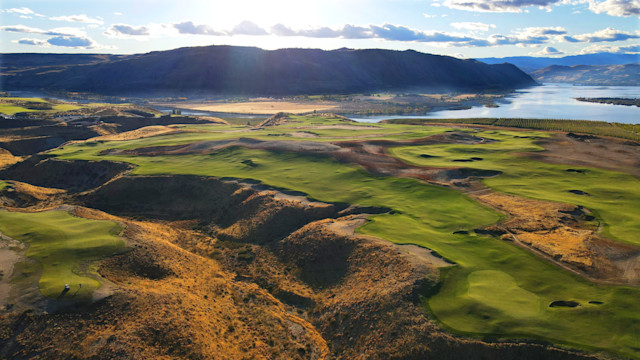Course Spotlight
The Broadmoor's East Course: Where Golf History Meets Mountain Majesty
By Brendon Elliott, PGA
Published on

The 2025 U.S. Senior Open returns to one of America's most storied golf venues this week, as The Broadmoor Golf Club in Colorado Springs prepares to host its third Senior Open and ninth USGA championship overall. At 6,300 feet above sea level, the East Course presents a unique challenge that has tested champions for over a century.
A Course Born from Vision

The story of The Broadmoor's golf legacy begins with Spencer Penrose's ambitious dream in 1916. Penrose envisioned transforming his rough mountain property into a world-class resort, and he knew he needed something special to anchor it. Enter Donald Ross, the legendary Scottish architect who had already made his mark on American golf with masterpieces like Pinehurst No. 2.
Ross declared The Broadmoor his finest work—quite a statement from the man who had just finished designing what would become one of golf's most revered courses. When the East Course opened in 1918, it held the distinction of being the highest golf course in the United States. That elevation isn't just a novelty; it fundamentally changes how the game is played here, with the thin air allowing balls to carry farther while creating unpredictable wind conditions that can humble even the most seasoned professionals.
An Evolving Masterpiece

The course we see today isn't exactly what Ross originally designed, and that's part of what makes it fascinating. In 1952, Robert Trent Jones Sr. was brought in to create nine new holes that would join with nine of Ross's original holes to form the current East Course. The remaining nine holes from Ross's original design became known as the "Back Nine" and were later incorporated into other configurations.
This blend of architectural philosophies creates a unique playing experience. Holes 1-6 and 16-18 showcase Ross's strategic brillianc —wide, tree-lined fairways that reward precision over power, with subtle green complexes that demand careful study. The middle stretch, holes 7-15, bears Jones's signature style with more dramatic elevation changes and bold design features that take full advantage of the mountain terrain.
Reading the Mountain Greens

USGA
Local knowledge becomes crucial at The Broadmoor, particularly when it comes to putting. The best advice seasoned players offer newcomers is deceptively simple: putts break away from the mountains. It sounds straightforward until you're standing over a six-footer with the Cheyenne Mountain foothills looming in the background, trying to decipher which way gravity and slope will take your ball.
The greens themselves are expansive by modern standards, reflecting the golden age design philosophy that rewarded approach shot accuracy while still allowing for recovery. But don't let their size fool you—they're filled with subtle undulations that can turn a seemingly straightforward putt into a three-putt nightmare.
A Stage for Champions

USGA
The East Course has witnessed some of golf's most memorable moments. In 1959, a 19-year-old Jack Nicklaus captured his first major championship here, defeating Charles Coe in the U.S. Amateur final with an 8-foot birdie putt on the 36th hole. Nicklaus later said that putt gave him the confidence to become the game's greatest major champion.
The course has also been the stage for breakthrough victories by some of women's golf's biggest stars. Annika Sorenstam claimed her first U.S. Women's Open here in 1995, while So Yeon Ryu won in a dramatic playoff in 2011. The Senior Open has produced equally compelling theater, with Eduardo Romero's commanding four-shot victory in 2008 and David Toms's clutch performance in 2018, when he made a crucial up-and-down on the 71st hole to secure his one shot victory.
This Week's Challenge

USGA
The 156-player field arriving this week will face a course that plays every bit as challenging as its championship pedigree suggests. At 7,355 yards from the tips, the East Course demands both length and precision. The tree-lined fairways punish wayward drives, while the elevation changes can make club selection a guessing game for those unfamiliar with high-altitude golf.
Weather will play its usual role in the Colorado mountains, with afternoon thunderstorms a constant possibility and wind conditions that can shift dramatically throughout the day. Morning rounds often play differently than afternoon rounds, not just because of the wind, but because the thin air becomes even more pronounced as temperatures rise.
The field includes nine former U.S. Senior Open champions, led by two-time winner Bernhard Langer, who at 67 continues to defy Father Time. David Toms returns as the defending champion from the last time the Senior Open was held here, while newcomers like Stewart Cink and Angel Cabrera bring fresh energy to the championship.
As the players tee off Thursday morning with the Rocky Mountains providing a breathtaking backdrop, they'll be competing not just against each other, but against a course that has been testing champions for more than a century. The Broadmoor's East Course doesn't just host golf tournaments, it creates legends.
PGA of America Golf Professional Brendon Elliott is an award-winning coach and golf writer. Check out his weekly column on RG.org, sign up for his newsletter, and visit OneMoreRollGolf.com to learn more about Brendon and his work.


